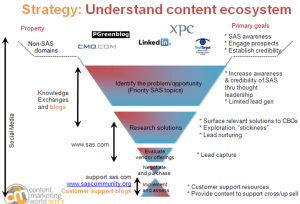Before I can even talk about blog strategy, I have to admit that I am not naturally a strategic thinker. I am rumored to be organized and slightly more analytical than your average writer, but I am first and foremost a creative, right-brained thinker.
This means my immediate reaction when colleagues start talking about strategy is to say, "Hey, how about you strategize amongst yourselves for the next six months, and I'll keep writing and publishing content in the meantime."
But we all know what the risk is in doing that, right? We burn out. We write and write and write and never know if what we've written met any goals or aligned with any business priorities.
But here's the good news: Most businesses have existing strategies you can plug in to. That means, as a blogger, you don't have to do all the strategic thinking up front all by yourself.
For the SAS blog program, we decided to align with three primary business goals: PR, marketing and customer support - and we selected measurements to analyze success in each area. You can see how our three goals for the blog program aligned with those areas:
- Become a primary source for SAS news & info (PR).
- Establish SAS employees as trusted advisors (marketing).
- Facilitate an ongoing dialogue with customers (customer support).

Next, in the strategic phase, we looked at where our content fit in the marketing funnel. The image to the right is an oversimplification, but it shows that our blog content would typically fit in the early buy cycle phases, and in the post-purchase, customer-support phases of the customer life cycle.
Finally, the third way we are aligning with business goals is to develop a metadata strategy that will align with our content management system, so blog posts can be used strategically within the content marketing cycle. This piece is still in the works and will not be implemented until 2012.
This is the first in a series of posts that will recap the content that I presented at Content Marketing World in the session, Results-Driven Blogging for B2B Brands. Lee Odden also wrote up a great summary of my presentation that has been especially popular with the Twitter crowd.

3 Comments
This is a great roundup post Alison and a I think your decision to support multiple business segments is a really good example of a holistic approach to content. Glad you liked my summary :)
The ecosystem diagram is very useful tool to communicate among constituents.
Thank you so much for this! Really loved reading and definitely had some great ideas.